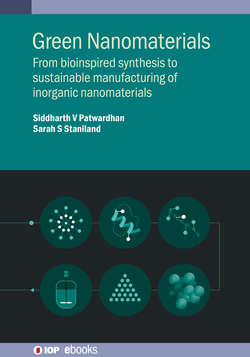Читать книгу Green Nanomaterials - Siddharth Patwardhan - Страница 11
На сайте Литреса книга снята с продажи.
1.1.3 Estimating environmental impact
ОглавлениеIn order to make informed decisions about the need for green innovations for a given process, it is important to assess the environmental impact of that particular process. There are various methods and tools available to qualitatively and semi-quantitatively analyse the environmental impact of processes [1]. Selected methods are described below with their principles, use, advantages and limitations.
Environmental factor (E-factor) [5, 6], also known as waste-to-product ratio (equation (1.7)), is a simple measure for identifying the amounts of waste/by-products produced with respect to the mass of the product.
E-factor=massofwasteandby-product÷massofproducts.(1.7)
Sheldon and co-workers [5] have studied E-factors for various industries and reported great variations from one industrial sector to another (table 1.1).
Table 1.1. E-factors for various sectors. Adapted from [5].
| Industry sector | Product capacity, tonnes | E-factor |
|---|---|---|
| Oil refining | 106–108 | ∼0.1 |
| Bulk chemicals | 104–106 | <1–5 |
| Fine chemicals | 102–104 | 5–50 |
| Pharmaceuticals | 10–103 | 25 to >100 |
The main reasons for such variations appear to be related to the product value/profit margins, relevant legislations, cost of waste and market competition. The E-factor analysis of a process is simple and provides quick estimates of wastefulness, which can lead to waste minimisation campaigns. While E-factor is easy to use, it can provide misleading information in some cases. For example, consider the following reaction:
Reactant1+Reactant2⟶SolventAproduct+waste.(1.8)
In reaction (1.8), when calculating the E-factor, if water is the waste, it will be treated as any other waste, although water is not inherently toxic or hazardous. In order words, E-factor does not take into account the nature and the actual impact of the waste or by-products and can treat waste on equal grounds despite significantly different environmental impacts.
Environmental quotient (EQ) [5] has been introduced in order to address the weakness of E-factor. EQ is essentially a modified E-factor, which takes into account the environmental ‘unfriendliness’ quotient (Q) of the waste or by-products (equation (1.9)). Effective mass yield (EMY) is another similar metric (equation (1.10)), which also disregards benign substances used or produced. Therefore, both EQ and EMY help to distinguish between hazardous waste and non-hazardous waste. However, both metrics are susceptible to inconsistencies due to the vagueness around what is environmentally unfriendly or benign, leading to debate over what values to assign to individual substances.
EQ=E-factor×Q(1.9)
%EMY=100×(mass of products÷mass of non-benignmaterials used).(1.10)
Life cycle analysis (LCA), is an extensive way of assessing the environmental impact and sustainability of a given process or product. LCA analyses the entire life cycle of a product, from the extraction of raw materials all the way to the fate of the product. In the context of nanomaterials, this has been extensively reviewed elsewhere [7]. This comprehensive analysis can overcome various pitfalls associated with the other metrics introduced above. However, performing LCA is laborious and time consuming, and it requires a large amount of process- and product-related data to be available. One important advantage of LCA is that for an alternative process or product, LCA can help differentiate between pollution/waste prevention and shifting pollution. For example, consider the reaction (1.8) shown above, and assume that the solvent A is a hazardous solvent. In order to remove the need for solvent A, an alternative reaction is available using a different precursor (equation (1.11)), where solvent B is benign:
Reactant3⟶SolventBproduct+waste.(1.11)
On the face of this new reaction, it appears to be ‘green’ because the hazardous solvent has been replaced with a non-hazardous one. However, during LCA, one needs to consider how the new reactant is derived (reaction (1.11)). Solvent C (equation (1.12)) used to produce reactant 3 may be as hazardous as solvent A. It quickly becomes clear that the alternative (reaction (1.11)) is not as green as it appeared.
Reactant1⟶SolventCReactant3+waste.(1.12)
Essentially, although the need for solvent A has been removed, in order to produce the same product, solvent C is required, thus simply shifting the problem to the synthesis of the new precursor. In addition, LCA can take into account the energy required to produce the desired products.
Carbon footprint is another measure for assessing the environmental impact of a process or a product. It estimates the CO2 equivalent emissions of greenhouse gases caused by a process or associated with a product. Carbon footprint analysis can help decide between processes where, for example, one option can produce a high quality product but require very high amounts of energy, while an alternative method could be lean on energy requirements but may produce a lower quality product.
